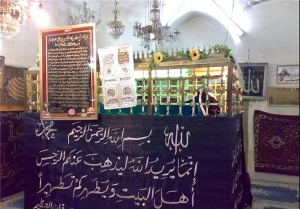Mashhad al-Saqt: Difference between revisions
No edit summary |
No edit summary |
||
| Line 1: | Line 1: | ||
'''Mashhad al-Saqt''' (Arabic: مَشهَدالسِّقْطْ) located three hundred meters from [[Masjid al-Nuqta|Mashhad al-Nuqta]], near Aleppo, [[Syria]], is among places where Shi’a visit. According to [[Shiʿism|Shi’ite]] tradition, it is the place where one of [[Hussain ibn Ali|Imam Hussain]]’s widows had a miscarriage. It is believed that the miscarried baby was named Muhsin, although there is no historical source to testify this name. | '''Mashhad al-Saqt''' (Arabic: مَشهَدالسِّقْطْ) located three hundred meters from [[Masjid al-Nuqta|Mashhad al-Nuqta]], near Aleppo, [[Syria]], is among places where Shi’a visit. According to [[Shiʿism|Shi’ite]] tradition, it is the place where one of [[Hussain ibn Ali|Imam Hussain]]’s widows had a miscarriage. It is believed that the miscarried baby was named Muhsin, although there is no historical source to testify this name. | ||
[[File:Mashhad al saqt.jpg|thumb|right|An interior view of the Darih of Mashhad al-Siqt, Aleppo, [[Syria]]]] | |||
==The Name of Mashhad al-Saqt== | ==The Name of Mashhad al-Saqt== | ||
Revision as of 12:50, 1 November 2020
Mashhad al-Saqt (Arabic: مَشهَدالسِّقْطْ) located three hundred meters from Mashhad al-Nuqta, near Aleppo, Syria, is among places where Shi’a visit. According to Shi’ite tradition, it is the place where one of Imam Hussain’s widows had a miscarriage. It is believed that the miscarried baby was named Muhsin, although there is no historical source to testify this name.

The Name of Mashhad al-Saqt
As the caravan of captives was on their way to Yazid’s court, one of the wives of Imam Hussain had a miscarriage. That is reason this place is named Mashhad al-Saqt meaning the place of miscarriage.
Story
While the caravan of captives stopped for a rest, a wife of Imam had a miscarriage. It is believed that there used to be a useful mineral in that area, but when its residents felt elated upon seeing the captives, Zainab invoked Allah’s curse against them; therefore, that mineral lost its useful qualities.[1]
History of Construction
In Tarikh of Ibn Abu Tay, it is cited that this place was originally called Mashhad al-Tarh where Sayf al-Dawla al-Hamdani used to sit and watch horse races. However, when he learned about the story of miscarriage, he ordered the construction of a mausoleum.
Source
- Yasin T. Al-Jibouri, Karbala and Beyond
- Shaykh 'Abbas Qummi, Nafasul Mahmum; Relating to the heart rending tragedy of Karbala'
Reference
- ↑ Karbala and Beyond, P. 119.